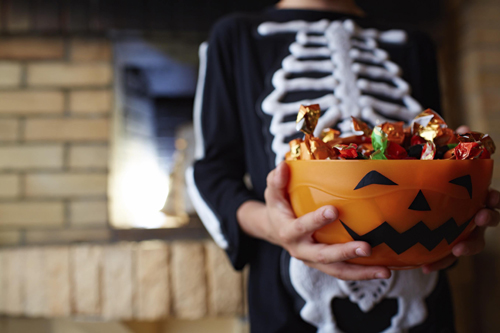
October is here and that means one important night to a kid: Halloween. And with Halloween comes every parent’s worst nightmare: CANDY! Many parents groan as they think of the sugary loot our littles bring in from the festive fall night. How can you best celebrate this holiday and navigate a spooky season without the nightmare of cavities post-Halloween?
As dentists, we are all too familiar with the dangers that can come with sweet treats. But worry not. According to a Delta Dental survey, most dentists do give out candy on Halloween (with most of them wisely choosing chocolate) and only five percent hand out toothbrushes. We say trick and treat your heart out, as long as you choose wisely.
Tip 1: Avoid Hard, Chewy & Sour Candy Culprits
Suckers, chewy and sour candies are some of the worst options for little trick-or-treaters. Jolly Ranchers, Jawbreakers, Runts, Fruit Roll-ups and Blow Pops keep sugar in the mouth longer than chocolate. A wise rule: the longer the candy stays in the mouth, the greater the likelihood for tooth decay. Chewy candies like Skittles, Tootsie Rolls, jelly beans, gummi bears and candy corn are also likely to linger in the grooves of teeth for hours and can create a higher acid content, making it easy for the enamel to break down. Sour candies like WarHeads, Wonka Fun Dip Powder and Lemon Heads have high levels of acid that can break down tooth enamel quickly. The acid levels of some sour candies may also be as bad as battery acid! Word to the wise: sticky is icky. Choose chocolate, which dissolves quickly.
Tip 2: Choose & Donate
Have fun with your little monster or princess by picking your favorite candies from the bag, together, and then donate the rest. This ensures a lifetime of moderation and healthy habits for your child, while simultaneously encouraging them to live generously. Organizations like Operation Gratitude give Halloween candy to military heroes, bringing a sweet surprise to someone overseas. Soldiers’ Angels Treats for Troops Program will ship your donated candy to deployed service members around the world or distribute to veterans in VA Hospitals across the country for a sweet treat! This year, Soldier’s Angels have partnered with www.HalloweenCandyBuyBack.com to provide drop-off locations around the country!
Tip 3: Eat & Drink
Enjoy Halloween candy shortly after a meal to ensure plenty of time for saliva to wash away the “sugar bugs.” Saliva production increases during meals and helps neutralize acids produced by bacteria in your mouth and helps rinse away food particles. One way to deal with this problem is to eat sweets with meals rather than as snacks, and avoid between-meal snacks when possible. Follow up eating by drinking plenty of water in order to prevent tooth decay. Sugary drinks like soda, juice and flavored waters create an acidic environment, increasing your chances for decay. Your best bet? Water for your little gremlin. When choosing bottled water, opt for fluoridated water, which contains fluoride at a level that is effective for preventing cavities.
Tip 4: Fuel with Healthy Foods
Talk with your child about the concept of food as fuel; what goes into the body, gives energy. The healthier the food, the more long-lasting energy your son or daughter will have. Encourage your child to fuel his or her body with healthy, high-protein foods, fruits and vegetables, which maintains energy throughout the day. Halloween treats are fun in moderation but sugar does cause energy spikes which quickly plateau. A wise rule of thumb: Fuel with 5 healthy foods to 1 sugary treat. Teach your child that what goes into our bodies provides energy throughout the day. Following meals or snacks, surprise your child with sugarless gum and give that mouth a 20-minute workout. Chewing gum after meals minimizes tooth decay, because increased saliva serves as a natural mouthwash, lessening food from staying in the mouth and neutralizing bacteria production caused by acid. Sugarless gum serves as a spontaneous treat in place of sweets.
Tip 5: Maintain Great Dental Habits
Youngsters should always remember to brush their teeth with fluoride toothpaste at least twice daily for two minutes in the morning and before bedtime. To prevent poor dental hygiene, children should attend regular dental visits every six months starting at age one. And don’t forget to replace toothbrushes every three or four months. Last but not least, floss teeth daily! Decay-causing bacteria get between teeth where toothbrush bristles can’t reach. Flossing helps remove plaque and food particles from between the teeth and under the gum line. The use of various floss aids, instead of regular floss, make flossing easy and fun and fit comfortably in a child’s hand.
By keeping these tips in mind, it is possible for your family to enjoy tradition, costumes, and even candy while avoiding a dental nightmare after Halloween’s passing.
By Richard Spaulding, DDS, Dental Director for Healthy Smiles for Kids of Orange County









Leave a Reply